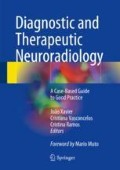Abstract
A 27-year-old woman woke up with right hemiparesis and dysphasia (NIHSS 13). Normal CT scan (◘ Figs. 30.1, 30.2, and 30.3).
Similar content being viewed by others
Keywords
These keywords were added by machine and not by the authors. This process is experimental and the keywords may be updated as the learning algorithm improves.
A 27-year-old woman woke up with right hemiparesis and dysphasia (NIHSS 13). Normal CT scan.
-
1.
What are the findings on these images?
-
2.
What are the possible aetiologies?
-
3.
Why is the treatment urgent?
Acute ischaemic stroke in patient with hereditary haemorrhagic telangiectasia (HHT) and a pulmonary AVM
FormalPara Answers-
1.
MR ◘ Fig. 30.1 – left posterior lenticular restricted diffusion; DSA ◘ Fig. 30.2 – MCA occlusion by thrombus with collateral circulation via pial anastomoses from the ACA and anterior temporal branch of the MCA, two small bilateral temporal AVMs; thoracic CT ◘ Fig. 30.3 – pulmonary arteriovenous malformation.
-
2.
Carotid dissection; carotid bulb atherosclerotic plaque (unlikely at this age); cardiac origin of the thrombus (patent foramen ovale, etc.).
-
3.
Mechanical thrombectomy performed in an early phase will allow reperfusion of the ischaemic penumbra territory, reverting the neurological deficits; if the patient is treated in a late phase, the recanalisation will be futile, with no improvement of the neurological deficits and with an added risk of haemorrhagic transformation of the infarct.
1 Comments
Hereditary haemorrhagic telangiectasia, also known as HHT or Osler-Weber-Rendu syndrome , is an autosomal dominant disorder with mucocutaneous telangiectasias and AVMs in visceral organs (primarily lungs, brain and liver) [1]. The most common clinical presentation is recurrent epistaxis from nasal mucosal telangiectasias. There is a significant lifetime risk of a brain abscess or stroke if a pulmonary AVM is present, as occurred with this patient. Pulmonary AVMs can be treated by embolisation or surgery with excellent results [2]. Most cerebral AVMs in HHT are low grade (Spetzler-Martin 1 or 2) and have a lower bleeding risk than sporadic AVMs . They can be treated with embolisation or radiosurgery, depending on the size and location of the AVM.
References
Krings T, et al. Neurovascular manifestations in hereditary hemorrhagic telangiectasia: imaging features and genotype-phenotype correlations. AJNR Am J Neuroradiol. 2015;36(5):863–70.
Osborn AG, Salzman KL, Jhaveri MD. Diagnostic imaging: brain. 3rd ed. Philadelphia: Elsiever; 2016.
Author information
Authors and Affiliations
Corresponding author
Editor information
Editors and Affiliations
Rights and permissions
Copyright information
© 2018 Springer International Publishing AG
About this chapter
Cite this chapter
Alves, V. (2018). Case 30. In: Xavier, J., Vasconcelos, C., Ramos, C. (eds) Diagnostic and Therapeutic Neuroradiology. Springer, Cham. https://doi.org/10.1007/978-3-319-61140-2_30
Download citation
DOI: https://doi.org/10.1007/978-3-319-61140-2_30
Published:
Publisher Name: Springer, Cham
Print ISBN: 978-3-319-61139-6
Online ISBN: 978-3-319-61140-2
eBook Packages: MedicineMedicine (R0)









